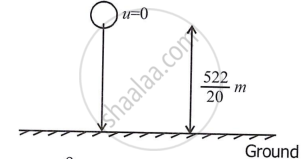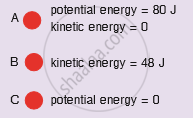Advertisements
Advertisements
प्रश्न
A stone of mass 500 g is thrown vertically upwards with a velocity of 15 m/s. Calculate:
- the potential energy at the greatest height,
- the kinetic energy on reaching the ground, and
- the total energy at its half-way point.
उत्तर
(a) Mass of stone m = 500 g = `500/1000 = 1/2 kg`

v = 0
u = 15 m/s
∴ v2 - u2 = 2gh
0 – 15 × 15 = 2gh
∴ gh = `(-225)/2`
10 h = `(-225)/2 or h = (-225)/(20) m`
A negative sign shows the stone is moving upward.
∴ Potential Energy = mgh
= `1/2 xx 10 xx 225/20`
= 56.25 J
(b) On the way back
u = 0, h = `225/20 m`, v = ?
v2 - u2 = 2gh
∴ v2 - 0 = `2 × 10 × 225/20`
∴ v2 - 0 = 225
∴ v = `sqrt225`
∴ v = 15 ms-1
K.E on reaching ground = `1/2 mv^2`
= `1/2 xx 1/2 xx 15 xx 15`
= 56.25 J
(c) Total energy at halfway point = mgh
= `1/2 xx 10 xx 225/20`
= 56.25 J
APPEARS IN
संबंधित प्रश्न
A metal ball of mass 2 kg is allowed to fall freely from rest from a height of 5 m above the ground. Taking g = 10 m s-2, calculate:
- the potential energy possessed by the ball when it is initially at rest.
- the kinetic energy of the ball just before it hits the ground?
State whether the object possess kinetic energy, potential energy, or both :
A man climbing a hill _____________.
Fill in the blank with suitable word :
The sum of the potential and kinetic energies of a body is called __________ energy.
Name the device or machine which convert :
Electrical energy into sound energy.
How much electrical energy in joules does a 100 watt lamp consume : in 1 minute?
Explain the transformation of energy in the following cases :
(i) A ball thrown upwards.
(ii) A stone dropped from the roof of a building.
What is the meaning of the symbol kWh? What quantity does it represent?
A ball falls to the ground as shown below :
Which law you have made use of in answering this question?
Which one of the following is not the unit of energy?
The device which converts mechanical energy into energy which runs our microwave oven is :
